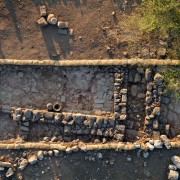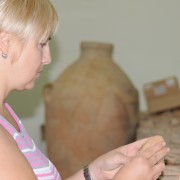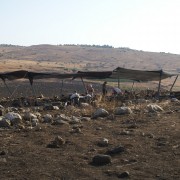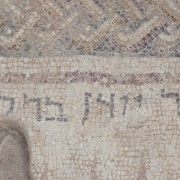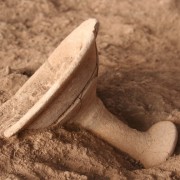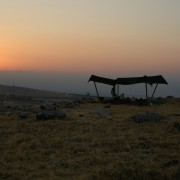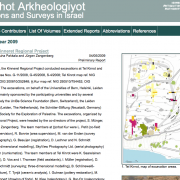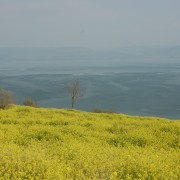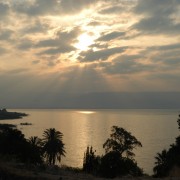Press Release: International Team Explores Rural Galilee and Finds Ancient Synagogue
Among many important discoveries, 2010 Kinneret Regional Project discovered an ancient synagogue, in use at around 400 CE.
Kinneret Regional Project (KRP, an academic consortium of the Universities of Bern [Switzerland], Helsinki [Finland], Leiden [Netherlands] and Mainz [Germany]) returned to the Galilee on June 21, the 2010 campaign will last until July 16 and is sponsored by the Universities of Bern (co-director Stefan Münger), Helsinki (co-director Juha Pakkala) and Leiden (co-director Jürgen Zangenberg).
New Discoveries at Horvat Kur
This year’s archaeological focus is the first systematic excavation on Horvat Kur, a village inhabited from the Early Roman through the Early Mediaeval periods located on a gentle hill 2 km west of the Lake of Galilee. 30 volunteers (mostly students of theology, religious studies and archaeology) and staff from the Netherlands, Finland, Switzerland, Romania, Belgium, Spain, Israel and Germany explore the material remains of village life in Galilee, a region that features very prominently in Early Christian and Rabbinic tradition.
Already after two weeks of excavation KRP the hardships of digging in the blazing Galilean sun were rewarded. Archaeologists worked in two different areas.
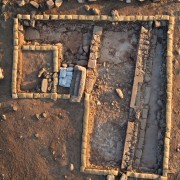
The western wall and main entry of the recently discovered synagogue of Horvat Kur; photograph by P. Partouche, SkyView Ltd.
In area A – situated on the hill-top – a narrow test trench dug in 2008 was expanded to a larger area (three squares, 5×5 m each), now being fully excavated. At this location, remains of an elaborately built monumental wall were discovered already at an early stage of excavation. This wall, preserved up to 80cm, runs North-South for at least 10m and clearly divides the excavated space into two different areas. To the west of it, a cobblestone pavement covered what we think was a small courtyard. In 2008 a large number of coins were found on the surfaces of this open space, indicating that the building represented by the above mentioned monumental wall might already have been in use at around 400 CE. During the 2010 campaign, another large amount of coins came to light in the same area which are likely to corroborate this dating once numismatic analysis of the newly found coin material is completed. Fragments of pilasters and other architectural elements were found close by in tumble, which will eventually contribute to the reconstruction of layout and design of the building.
To the east of the monumental wall we found a totally different situation, indicating that this space was inside the building. Here, a low bench made of hewn stones and covered with grey plaster, runs alongside the wall, only interrupted by an entrance roughly in the centre of its excavated part. The floor was made of grey, hard plaster. It will need to be checked in the future if there are additional floor layers below.
Taken all the available evidence together, it seems very likely, that KRP 2010 has discovered a part of the western wall of yet another ancient Galilean synagogue. Together with the well-known synagogues at Capernaum and Chorazin (both ca. 5th / 6th c. CE) and the recently discovered ones at Khirbet Hammam (2nd / 3rd c. CE) and Magdala (1st c. CE), the new synagogue at Horvat Kur (tentatively dated to the 4th / 5th c. CE) adds new evidence for a very tight net of synagogues in a relatively small area on the Northwestern shores of the Lake of Galilee.
In area C on the fringe of the topmost plateau of Horvat Kur, parts of two courtyards with work installations and a room full with dumped pottery from the middle of the 1st millennium CE came to light that allow fascinating insights into social and economic life in a Galilean village during this period. Recycled architectural elements (spoliae) and broad walls made of fieldstones or reused ashlars demonstrate how frequently village space changed to adapt buildings to the needs of their inhabitants. Future excavations will expose the entire structure and allow analysis of the use and organization of space of the inhabitants. The expedition will aim to unearth traces of earlier habitation to clarify the development of the village.
Remains from the domestic quarter in C and the public area in A will substantially add to our knowledge of ancient rural Galilee and thus substantially contribute to solve current research questions like population growth and economic status or cultural interaction of indigenous and external influences in rural Galilee throughout the classical period. In addition, the new finds and findings at Horvat Kur will contribute substantially to the ongoing, fierce debate about the chronology of Galilean synagogues.
Analyzing Finds from Tel Kinrot
KRP also continued its work on the material remains of Tel Kinrot, a large site situated directly on the shore of Lake Kinneret ca. 11 km north of modern Tiberias. To date archaeological investigations revealed settlement layers from the Chalcolithic throughout the Ottoman periods (ca. 5th millennium BCE to 2nd millennium CE). The site was under excavation by KRP until 2008. After that a small, in-lab team of experts continuously analyzed the finds and findings from the various settlement layers in order to prepare them for subsequent publication.
During the 2010 study season special focus was laid on the examination of the city layout and the analysis of the architecture in the domestic quarters dating to the Iron Age I period (11th and 10th c. BCE). In addition, the catalogue of the hitherto retrieved small finds, especially those relating to textile industry, could be further completed. As in previous years, the restoration of the uniquely well preserved pottery assemblage of the Iron Age I period was continued.
Prospects
Future campaigns will return to surveying the region around Horvat Kur and record agricultural installations (already started in 2008), explore the many caves and cisterns on the site to better understand Horvat Kur’s water supply system and – of course – to continue excavations on the hill itself. A lot remains to be discovered on Horvat Kur!
After final publication of the results of the first phase of KRP’s activities at Tel Kinrot, fieldwork at this important site will be resumed. At the same time, the site’s preservation and conservation or restoration of excavated areas will be continuously pursued in collaboration with the authorities.
KRP will henceforth also be committed to its educational field programme for international students of all disciplines to bring them into hands-on contact with the history and material culture of a region that is at the foundations of both Judaism and Christianity.
All these activities, of course, require money; raising sufficient funds will therefore have top-priority to make our plans happen.
Kinneret Regional Project 2010 wishes to thank the Israel Antiquities Authority for granting the excavation license and various logistic support, the owner of the land on which Horvat Kur is located, the Deutscher Verein vom Heiligen Land, the Schröter Foundation (Neustadt/Germany), the Universities of Bern, Helsinki and Leiden for generous support and our colleagues Benjamin Arubas, Mordechai Aviam, Dina Avshalom-Gorni, Hava Katz, Uzi Leibner, Eric Meyers, Yinon Shivtiel and Yosef Stepanski for advice and encouragement.

